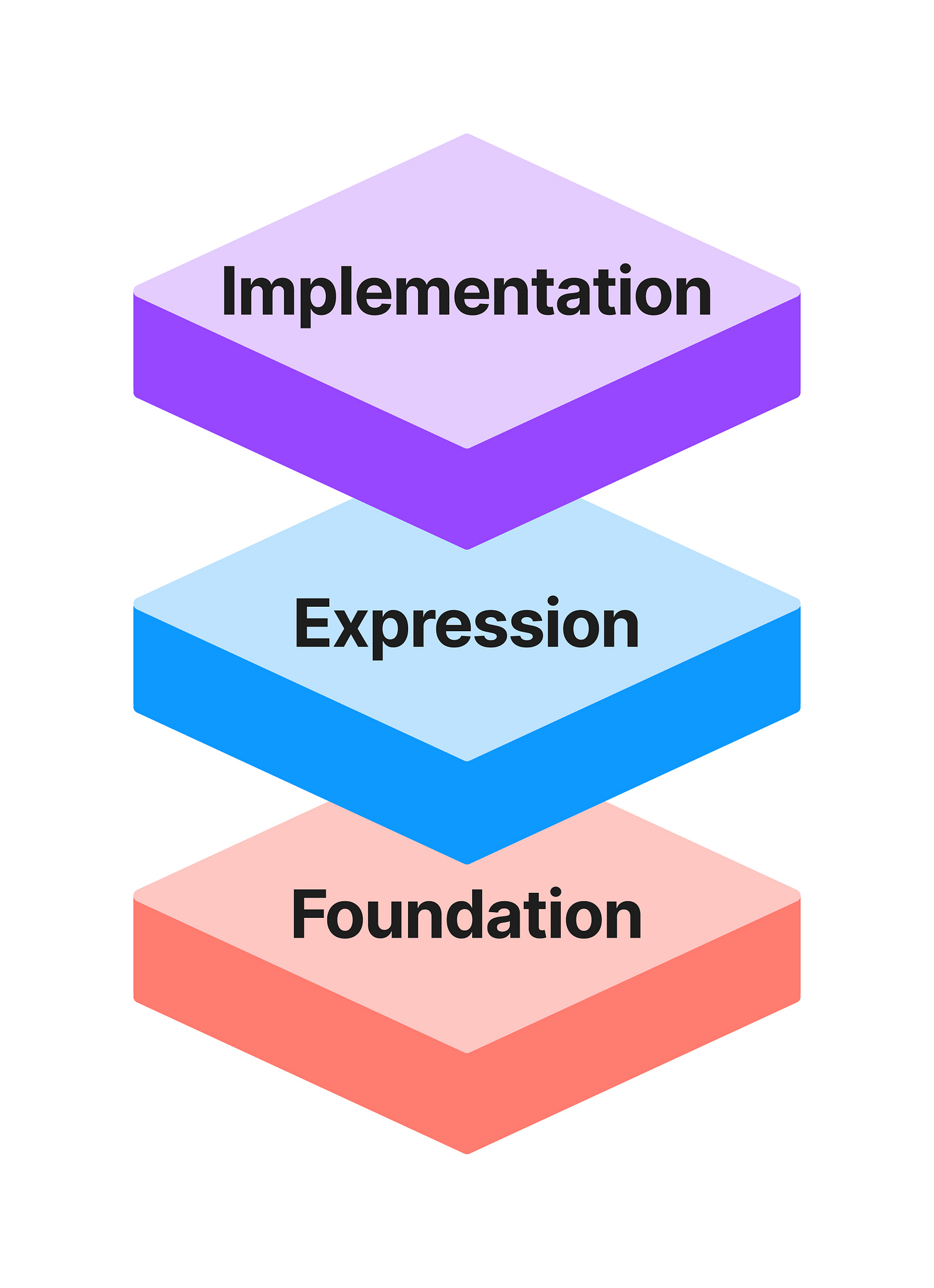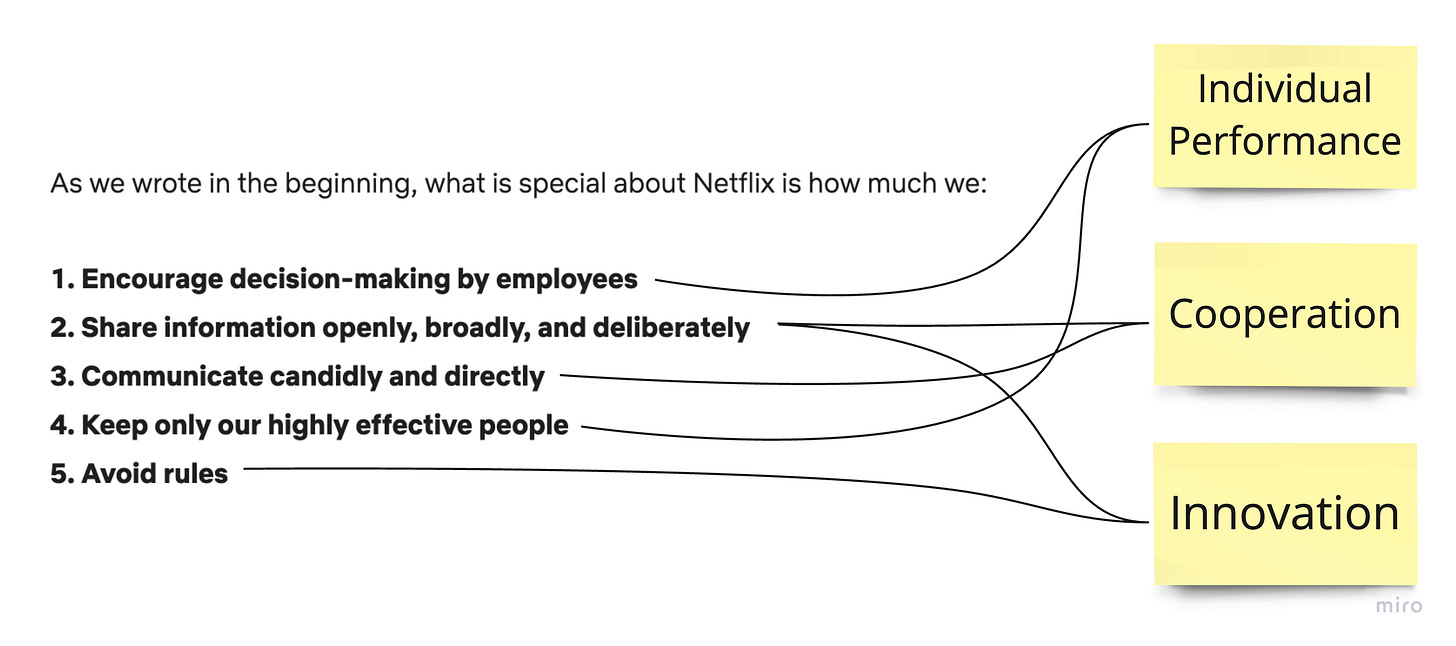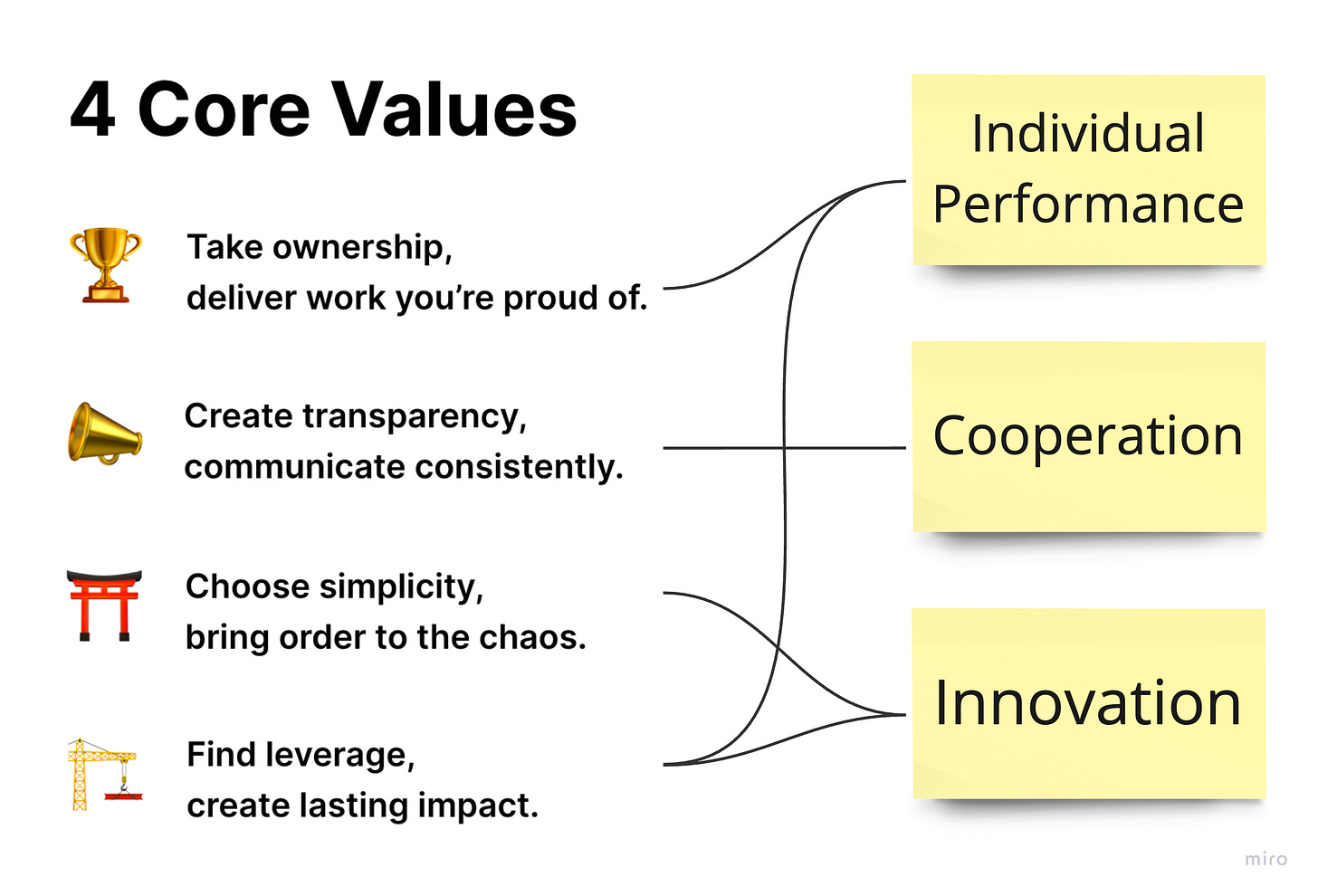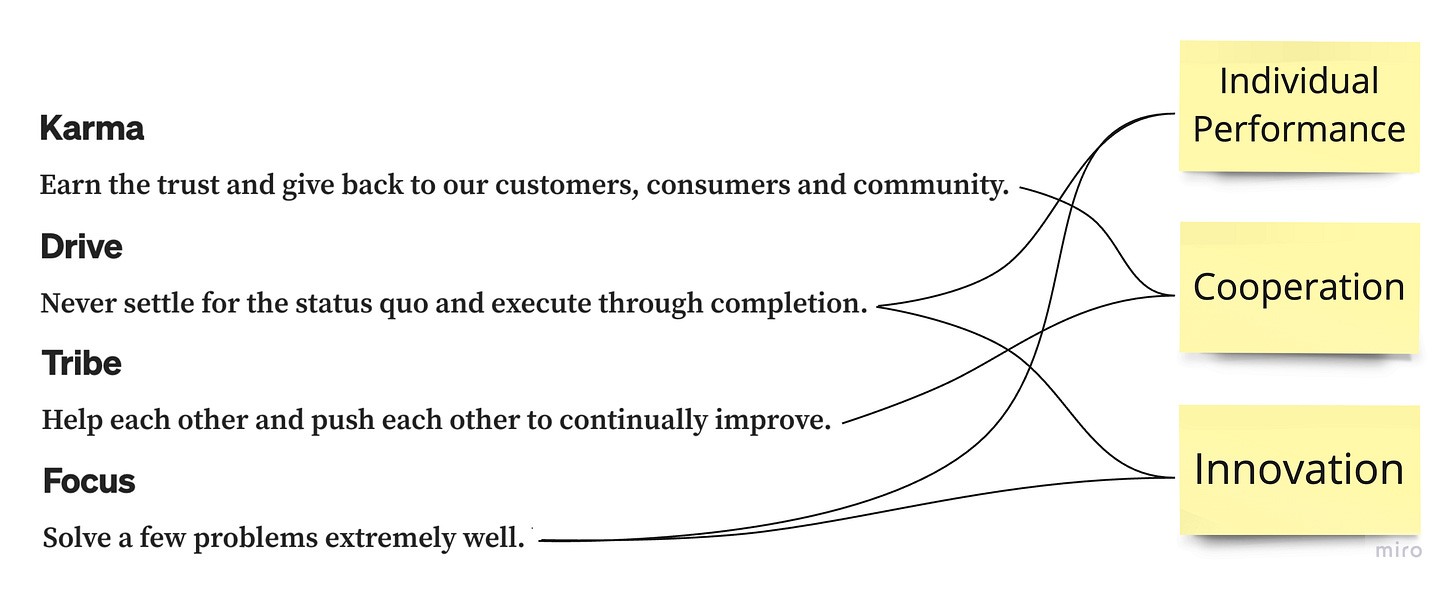Table of contents
The Stack
At their core, the cultures of great organisations aren’t that different. They all have some emphasis on individual performance, cooperation, and innovation. They all want their employees to get sh*t done, go the extra mile, work together, and be bold. Let’s call these three values - individual performance, cooperation, and innovation - the triad. If this triad doesn’t change across great companies where, then, does company culture vary?
The real variance happens at two levels. The first is about expression - How does a founder express the above triad of values into a repeatable, relevant, business-worthy story? The second is about implementation - how does a founder implement and operationalise this story in practice?
This gives us three abstractions for thinking about culture; a foundation of values, the expression of those values, and the implementation of that expression. These abstractions are clearly ordered. The programmer in me sees a stack.
Let’s call this the “culture stack”.
Let’s work through this stack, bottoms up, and see what it means in practice. I will give examples throughout, using well-known names in tech alongside up and coming startups.
Foundation
This changes the least across successful companies, and has three pillars:
Individual performance - high standard deliverables, taking initiative, self-improvement, honesty, facing reality
Cooperation - trusting your colleagues and their skills, treating your colleagues as you would like to be treated, shared purpose, strong communication
Innovation - Curiosity, openness to outside thinking and new ideas, emphasis on data and facts where available, nonhierarchical teams
Each company will weigh these slightly differently. There is an inherent tension between these three pillars. For example, individual performance can be at odds with collaboration and openness. It is the job of leadership to manage this tension, calibrate it, and adjust it as the company evolves.
A company’s foundational values might not explicitly include the above triad, but they are always reducible to them. If you look at any successful company with a public set of values, the majority of them will pertain to the triad. The rest are peripheral to performance, and are more about company behaviour - for example values around customer obsession or environment responsibility.
The outcome from considering this layer is a simple list of values, consisting of the above triad, and whatever else you as a founder think is critical to your business.
Expression
In Gabbi Cahane’s1 Reals/Feels dualism, this is about the feels. What does this culture feel like? How do we express its values to current and future employees? What is the memorable(humorous, analogous, etc.) story-like statement that brings employees back to these values?
The outcome here is content. A document, deck, video, etc. that captures the story of your company and its culture. This should be easily accessible, featured in many places, digital and physical, and it should be repeated often by leadership.
Let’s consider two examples of codifying culture; Netflix and Calliper. Netflix is Netflix. Calliper is a London-based seed-stage startup backed by Sequoia that wants to build the collaborative analytics platform of the future.
How does Netflix’s cultural expression feel? It feels exciting and demanding. It feels energising for autonomous, driven individuals. It makes me think of a loosely coupled but tightly aligned group of passionate people working towards a common goal, constantly evolving as individuals and as a team. Those are the feels. You can see how their values map to the triad below.
How does Calliper’s cultural expression feel? An awesome feature of Calliper’s team is their very public practice of cultural evolution. Their culture decks are versioned - they embrace the iterative, imperfect, mistake-filled path of company building. Their deck feels organised and self-aware. Each cultural value has an internal perspective, a customer perspective, and a trade-offs section and there are even guidelines for building values. Even if you ignore the cultural values themselves, there is so much around them - meta values - that tells you what this team is like; self-aware, thorough, and committed. Triad mapping below.
To wrap up expression, the outcome of this layer should be content and the emphasis should be on how that story is told. It should be true to the founding team’s personality, the company’s mission, and their foundational list of values.
Implementation
Onto the reals. The practicalities. The things that bring the above expression to life. The rituals and processes that buttress the culture. How do we as a group make clear what we celebrate, tolerate, and reject? How can we regularly connect to the feels? How can our culture energise us?
The outcome here is rituals and process. This is a very fluid outcome. In the early days these rituals will always be experiments. Good leaders and strong teams will try things out, see how they feel, and iterate - grounded in their values and the story of those values. There’s an infinite number of things you can do here, and there is enough written about operationalising culture2 - I won’t delve into it. My only point is to make sure there are physical rituals. Find something culturally fitting for the office, or send a desk accessory to your remote team. It is easier to attribute meaning to physical, tangible artefacts.
Let’s consider two examples of operationalising culture: Segment and LatchBio. Segment facilitates data governance and data integration, and was acquired by Twilio for 3.2B USD in 2020. LatchBio is building the cloud for biology to accelerate biotech research. LatchBio is backed by Lux Capital, Fifty Years, General Catalyst and others, and raised their Series A in 2022.
Segment’s cultural rituals as it grew is captured in this tweet by one of their founders Ilya Volodarsky. He stresses the importance of thinking about your culture as a product that will go through many iterations. His thread covers early day rituals such as building furniture together as well as timeless best practices such as making All Hands amazing. He also acknowledges that as the company scales each team will develop its own sub culture. If we look at Segment’s cultural foundation, there’s a clear mapping to the triad:
Looking at LatchBio and the early stage they are at, their highest leverage cultural implementation is who they hire and the tone they set. If you look at their job postings, for example for a Bioinformatics Engineer, notice their emphasis on three things: work ethic - they expect you to work six days a week in-person, deep understanding - they expect you to understand the math behind the software, and scientific/intellectual curiosity - they hold weekly systems and math reading groups. These three values and practice alone are enough to set the cultural stage for LatchBio’s growth. They strongly emphasise individual performance and innovation and they make clear what energises them; science and hard work.
That concludes the top of our culture stack - implementation.
Those are the three layers. Like any stack, layer n is dependent on layer n-1. Changes to implementation should revisit expression, and changes to expression should revisit the foundation.
What does this mean in practice?
As a stack, this frameworks makes two key arguments. First, that cultural deliberation must be grounded in the foundational triad of individual performance, cooperation, and innovation. Second, that you should deliberately work through this stack whenever you’re revisiting your culture. Rethinking your values? How will that change expression and implementation? Rethinking some cultural practice? Is that in line with your expression and foundation?
In the day-to-day chaos that is sometimes startup life, this framework can provide structure to your thinking, and facilitate more deliberate decision making. Let’s consider this framework in context for founders and investors.
For founders
For founders, this framework provides a sequence of questions to work through; What do you want see in your company’s culture? How are you going to tell that as a story? How are you going to operationalise this story into a reality? Not following this order will prove problematic. You shouldn’t start forming your personal founder story before establishing the foundational values you want to embody. Equally, you shouldn’t jump to thinking about cultural practices before you’ve shaped your story. Naturally, company culture will evolve, and culture building is an iterative process. With each iteration, this framework can be used to deliberately work through the layers of your culture.
At the early-stage a culture stack might look like this:
Foundation - quickly hashed together list of values and ideals
Expression - copied over from your pitch deck
Implementation - hiring
This reflects the extremely limited time and bandwidth a founder faces, especially in the early-stage. The emphasis on hiring makes sense, your first several hires will set the stage for the rest of the company and will undeniably influence culture. Focusing almost exclusively on hiring is a sensible operational shortcut. This framework only emphasises that before you dive into hiring - an implementation detail - you deliberately work through the rest of the culture stack.
In the later-stage, the stack will mature:
Foundation - refined set of values
Expression - polished narrative
Implementation - everything. Hiring, firing, onboarding, offboarding, etc.
Founders that embody this deliberate, grounded thinking are able to effectively internalise this framework. They don’t need to revisit a doc. They know exactly what kind of culture their ambitions demand, and how to make that culture a reality.
For investors
For investors, this is a means to evaluate founding teams. How effectively a founder leverages these foundations and expresses them to their team will demonstrate their storytelling skills and EQ - what they’re like as a leader. How effectively a founder implements their culture using rituals and processes demonstrates their leadership, as well as organisational, skills - what they’re like as a manager.
The congruence of a startup’s culture stack, from its stated values to its day-to-day practices, means something. Incongruence across the stack could hint at incoherence in the founder’s thinking. This should by no means be a deal breaker in itself, many successful companies where messy at the start, but perhaps it should warrant another discussion with the founder.
Wrapping up
We now have a framework that abstracts the composite phases of building company culture - foundational values, expression, and implementation - as a stack. Like any mental model, it is only valuable if its structure provides a helpful lens to view and think about reality. Also like any mental model, it is reductive and omits some details to emphasise others. Each of the three layers likely interact with and influence each-other more than suggested here.
One key omission is at the foundation layer. The triad is about the minimal set of values needed for a group of people to produce long-term value. "minimal” is the key qualifier here. There are numerous other values companies have espoused in their cultures; customer obsession, commitment to privacy, and environmental responsibility, to name a few. These are ignored because they are not necessarily shared across companies, while the triad is3.
Another is the omission of practical details. This is a high-level model, and leaves out the soul searching, story writing, culture creating details that founders face at each layer.
It is my non-empirical opinion that many founders leave their culture up to chance. For whatever reason, they don’t own the entire culture stack. It is one of the most personal parts of company building. You have to put yourself, your values, and your story out there, and then you have to make them work. This requires introspection at the foundational and expression layers, and bravery and vulnerability at the implementation layer. That is why this framework intentionally overemphasises a structured, deliberate approach to culture building. Own the stack!
Ultimately, culture is an emergent phenomenon and companies are complex organisms. Leaders have the daunting task of navigating this complexity. I’ve tried to tame it with the above framework. It is by no mean exhaustive or conclusive. Let me know your thoughts!
Addendum
07/01/2024 - in hindsight this should have been two articles, because it makes two related but distinct points; (1) that optimal cultures focus on the triad and (2) introducing the culture stack framework
What I’m reading this week
VCs at Work, by Tarang Shah and Shital Shah
The Price of Time, by Edward Chancellor
Spaces I’m looking into this week
Firetech, Convective Capital, and climate resilience tech more broadly
Could not find reference to Reals/Feels dualism, but here’s the man himself
Brave New Work, Mochary Method, Radical Candor, this YC lecture, etc. etc.
Inspiration for this triad comes from Prof Eric Beinhocker’s book The Origin of Wealth







